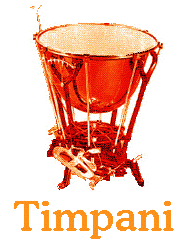Timpani
Timpani
Contents :
History
The timpani originated from the different forms of the kettledrums. The nakers from Arabic origin were found in medieval Europe. These developed into the European kettledrums, or timpani.
Percussion instruments often were used to represent something. As late as the 17th century, timpani were associated with royalty in Europe.
The timpani instrument was a kettledrum placed on a stand often made of wood. This was changed over the centuries until the drum and stand were merged into one object.
The machine timpani was developed in the 19th century. It was made to reduce the amount of time needed for tuning. This was accomplished by turn handles which ensured equal tension at all points on the drum head.
Foot pedals were developed and found to be a quicker way of tuning. They are used widely today.
Top
Description
Timpani are made in various sizes. They include a single head which is placed over a bowl-shaped shell. Timpani are usually tunable and played in pairs.
The shell is made of metal, usually copper. The head is made of animal skin or plastic. There are two hoops for each head. The bottom hoop is around the edge of the head. It is attached to the shell with tension screws attached to the top hoop placed over the head. This top hoop pushes against the bottom hoop to hold the skin taut.

Top
Sound Production
Sound is produced when the player creates a vibration by striking the drumhead with a padded stick. This vibrates the skin of the drumhead. The copper wall then acts as a resonator.
The pitch is determined by the tension placed on the head by the hoop. The more tension, the higher the pitch. Also, hard and soft beaters offer tonal variety. Notes are produced when the head is struck by the performer.
